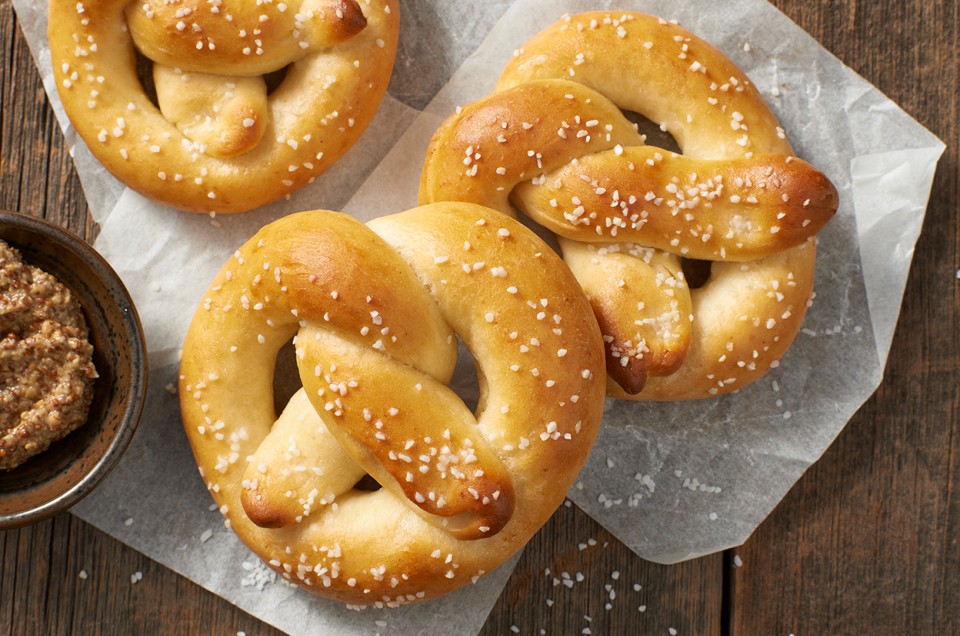


What is it about feeding sourdough starter that bothers so many of us?
Discarding that initial cup of perfectly good starter to get the process going, right?
I mean, it just doesn't feel right, throwing away this starter you've been feeding, and coddling, and nursing into maturity with regular meals and draft-free, comfortably warm counter-time.
Why is it, anyway, that feeding sourdough requires you to discard a cup of perfectly good (albeit unfed) starter as part of the process?
Well, most people say it's “so your refrigerator won't be overrun with starter.”
But that doesn't make sense. Since you're going to remove a cup of fed starter to bake with, why not just count that as the “discard,” rather than remove an additional cup?
Here's what I think: it all has to do with the yeast's desire to eat and grow.
If you add flour and water to your starter without removing any of the starter first, the flour won't feed as many hungry little yeast cells. But if you remove some starter first, before feeding, there's more new food, proportionally, for the yeast.
So why not just leave the starter as is, and feed with MORE flour and water than normal, to accommodate all the yeast?
Because, unless you're making some really major sourdough recipe, you'll be feeding with more flour/water than what you're removing to bake with – usually about a cup.
Keep that up for very long, and you WILL have to deal with The Starter That Ate Manhattan.
So, we're back to ”I hate to throw away starter.”
And you don't have to. Take that cup of “discard,” and make pancakes or waffles. Or cinnamon-apple flatbread. Or sourdough pizza crust.
Multigrain sandwich bread is a great use for your sourdough discard, as is sourdough carrot cake with cream cheese frosting.
Sourdough Pretzels, anyone?

OK, does your sourdough ever look like this?
Mine does - regularly. Dark liquid on top, kind of a pitted appearance to the solid matter underneath...
It's OK; really. I pour off most of the liquid; it's mostly alcohol. You can stir it in if you like, then add less water than you normally do when you feed the starter.

Stir any remaining liquid into the starter. Remove 1 cup, and either bake with it (re-read suggestions above), or discard. Transfer the remainder to a bowl.

Add equal parts unbleached all-purpose flour and lukewarm water by weight – which is about 1 cup flour and 1/2 cup water.

Stir to combine. Cover.

Several hours later (if your starter is pretty vigorous to begin with), or the next day, it should be nice and bubbly again.
If it's not – remove 1 cup, and feed the remaining starter again.
Once it's bubbly, store in the refrigerator until the next time you're baking something sourdough – or until you forget it, remember it, your conscience finally gets the best of you, and you feed the poor thing!
At last - we're ready to make those pretzels.

Put the following in a mixing bowl:
3/4 cup lukewarm water*
1 cup unfed sourdough starter, straight from the refrigerator (or use fed starter if you like)
3 cups Sir Lancelot Unbleached Hi-Gluten Flour* or King Arthur Unbleached All-Purpose Flour
1/4 cup Baker's Special Dry Milk or nonfat dry milk
2 tablespoons (1/2 ounce) non-diastatic malt powder or 1 tablespoon sugar
1 tablespoon butter or vegetable oil
1 1/2 teaspoons salt
2 teaspoons instant yeast
*Add an additional 2 tablespoons water if you're using high-gluten Lancelot flour.

Mix until you've made a cohesive dough.

Knead the dough – by hand, mixer, or bread machine – until it's smooth.

It should be slightly sticky, like this; if it seems dry, knead in an additional tablespoon or two of water.
Shape the dough into a ball, and place it in a lightly greased bowl. Cover the bowl, and let the dough rest for 45 minutes.

It isn't going to rise a lot; but it'll definitely grow a bit. Check out the rivet marks in the bowl, on the upper left of the dough...

See the difference? Two of the rivet marks have disappeared. It's definitely growing.
Now, start preheating your oven to 350°F.

Turn the dough out onto a lightly greased work surface; a silicone rolling mat work well. Fold it over a few times to gently deflate it, then shape it into a rough rectangle.

Score it once lengthwise, and five times crosswise, to make 12 pieces.

Gently cut the dough into pieces; you don't want to cut into the silicone mat, if you're using one.
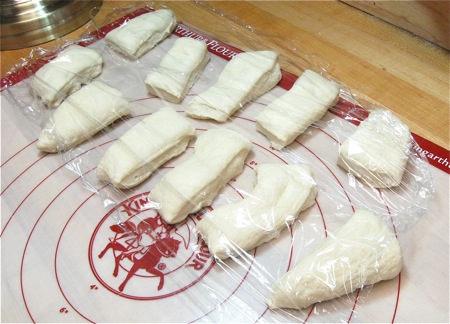
Cover the dough with plastic wrap, so it doesn't dry out as you're working with the individual pieces.

Roll each piece of dough into an 18" rope. Keep the finished ropes covered, so they don't dry out.
You may find it easiest to roll all the ropes partway, then go back and roll them the rest of the way. That way, each has a chance to rest (and the gluten to relax) as you're working on the other ropes.
Now we're going to shape pretzels.
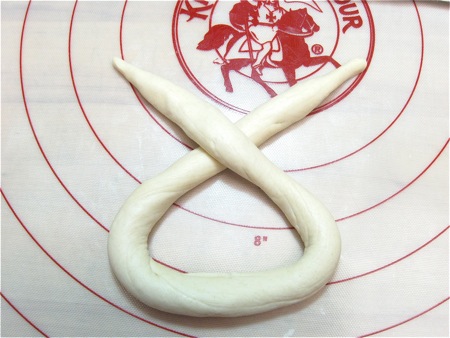
First make a loop.

Then grab both ends, and bring them over...

...then tuck them under.

For an extra twist, make the loop...

...twist its ends...

...and bring down and under.

Place the shaped pretzels on two parchment-lined (or lightly greased) baking sheets. Once they're on the sheets, gently tug them into as nice a shape as you can.
You're going to bake the pretzels right away, so don't bother covering them - unless it's taking you a REALLY long time to shape them.
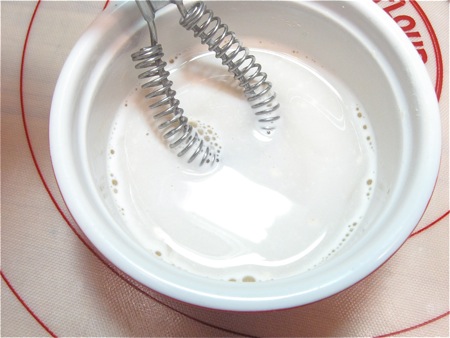
Dissolve 1 tablespoon non-diastatic malt powder (or sugar) in 2 tablespoons lukewarm water.

Brush this solution onto the pretzels; it'll help them brown.
Why don't we use baking soda dissolved in water, as so many recipes do?
Because darned if we could ever get the baking soda to fully dissolve, no matter what we tried. And the resulting solution gave the pretzels a splotchy, messy look.

Sprinkle the pretzels with coarse pretzel salt, if desired.

Bake the pretzels for 25 to 30 minutes, until they're a light golden brown.

Remove them from the oven, and brush with melted butter, if desired.
I desired. There's nothing quite so satisfying as hot bread and butter.
Hot, chewy, golden pretzels and butter? I'm there.
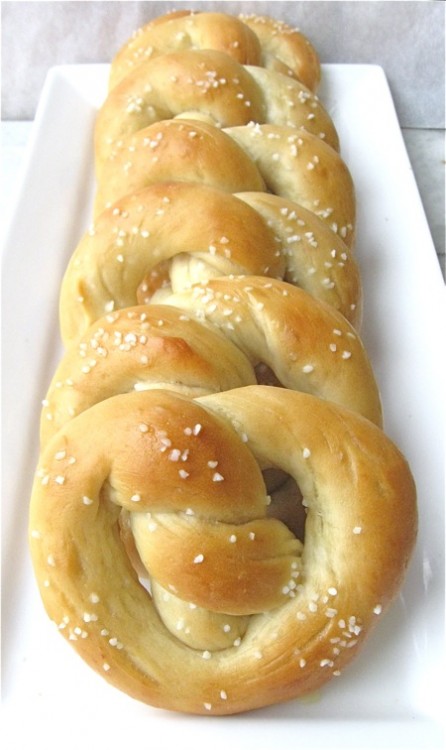
Read, bake, and review (please) our recipe for Sourdough Pretzels.